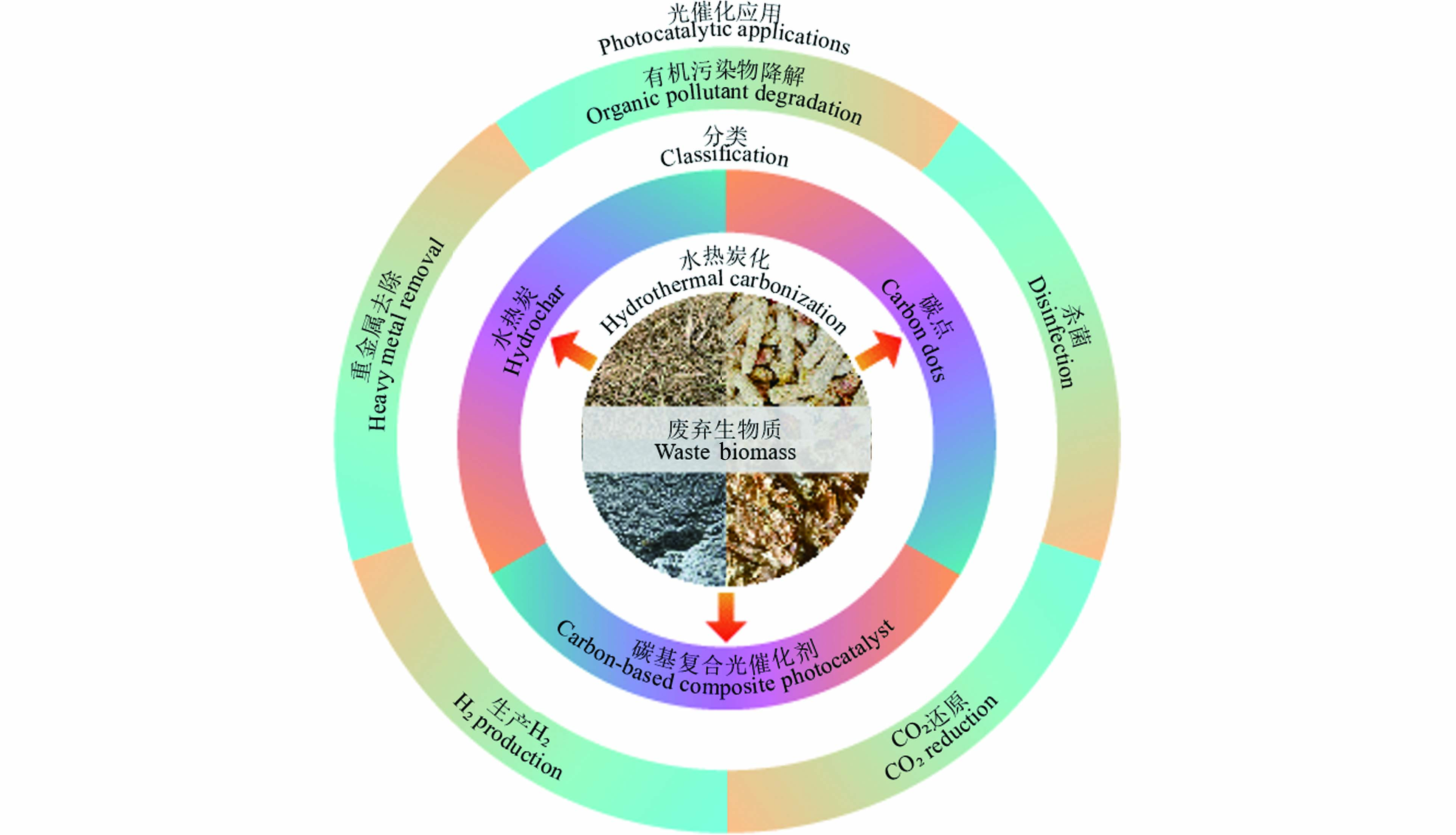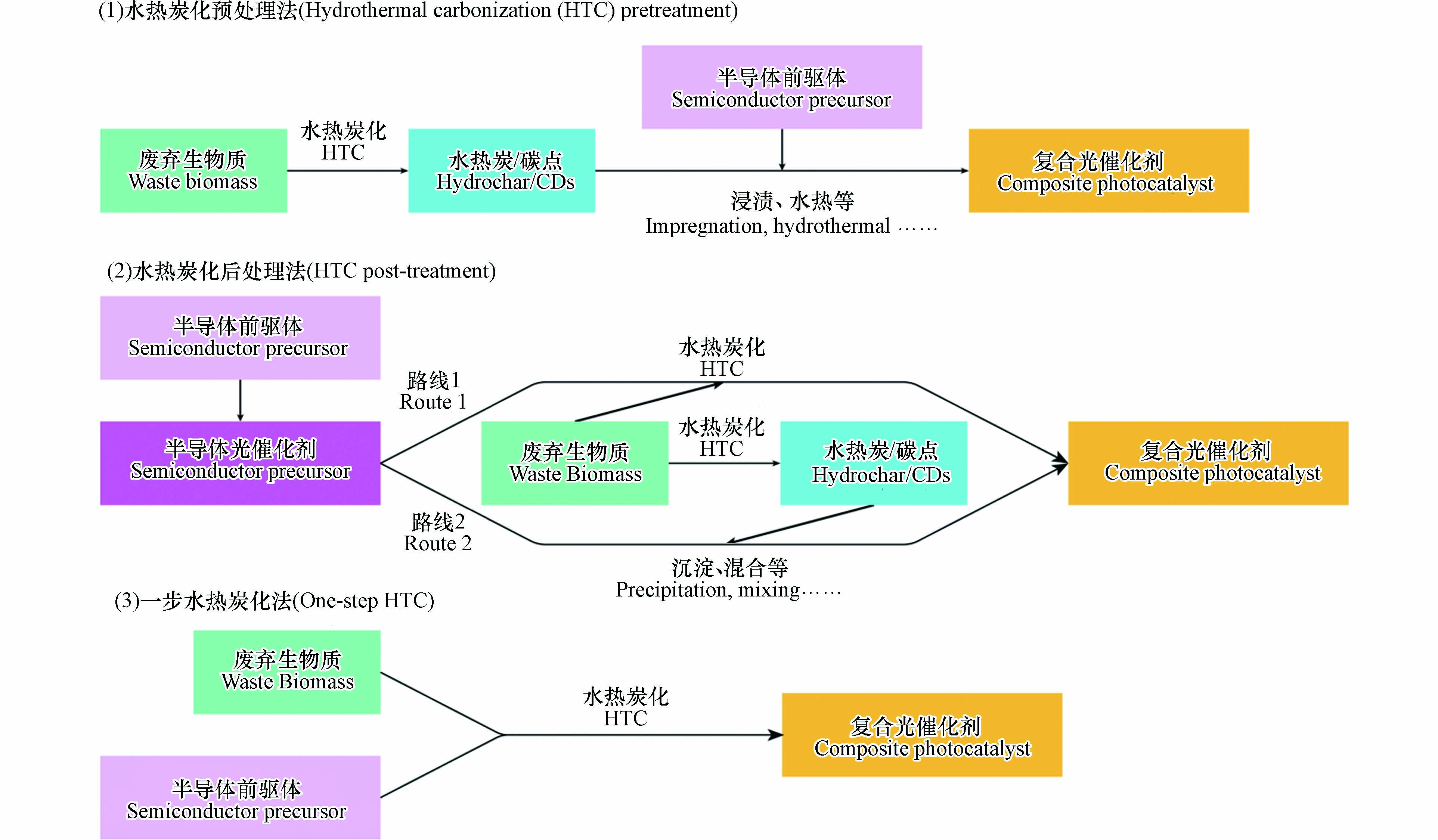-
废弃生物质是生产和生活过程中产生的富含有机物质的废弃物,包括农林废弃物、畜禽粪便、食品加工废弃物、厨余垃圾和城市污泥等. 我国每年产生大量废弃生物质,其中仅约20%—30%被以堆肥或焚烧等低价值方式利用,剩余部分则被填埋、焚烧或丢弃到环境中,带来很大的处理压力和环境风险[1]. 废弃生物质的碳含量通常较高(质量分数为45%—55%),可以通过热化学技术将其转化为碳基功能材料,既可以满足废弃物减量化的需求,又实现其高值资源化利用. 传统碳基功能材料不仅以煤和石油等不可再生的化石为原料,也需要苛刻的制备条件并消耗大量能源. 因此,亟需开发更加符合绿色化学要求的碳基功能材料的制备技术. 水热炭化是一种兼具成本效益和环境效益的热化学转化技术,反应条件较温和,设备要求简单,原料容差性高,具有经济、高效和环保等特点. 废弃生物质通过水热炭化制备的水热炭、碳点和碳基复合材料在能源和环境等领域有广阔的应用前景[2].
光催化被认为是解决能源危机、温室效应和环境污染等问题最有效的技术之一,目前许多光催化剂存在制备成本高、可见光利用率低和稳定性差等问题,严重限制其大规模的商业化应用. 开发低成本的高效光催化剂、提升传统光催化剂的性能是目前研究的重点. 生物质通过简单的水热炭化制备的水热炭和碳点具有光催化活性,并且在改性之后表现出超过TiO2、g-C3N4和CdS等传统半导体光催化材料的光催化性能. 此外,水热炭化也可以将传统半导体光催化材料与生物质衍生碳复合,构建碳基复合光催化剂来改善其光催化性能. 以生物质尤其是废弃生物质为碳源的水热炭化制备廉价、高效和稳定的碳基光催化材料,具有巨大的应用潜力.
目前,已经有大量研究以废弃生物质为原料,通过水热炭化制备碳基光催化材料,并将其应用于环境和能源等领域. 有必要对这些研究进行系统性的总结,分析其优势和不足,展望未来的发展方向. 本文梳理了水热炭化制备的废弃生物质衍生碳基光催化材料的最新进展,归纳其制备方法、光催化机理和应用领域(图1),为未来更深入的研究提供理论指导、启发新思路和预测发展方向.
-
1913年,诺贝尔化学奖获得者弗里德里希·贝吉乌斯(Friedrich Bergius)发现在一定温度压力下纤维素能够在水中转化为类煤材料,并将这一过程命名为水热炭化. 通常,水热炭化发生在100—350 ℃,停留时间为数分钟到数十小时,生物质经过水热炭化后会发生明显的物理化学性质变化,例如颜色变为棕色到深褐色、碳含量显著升高. 如今,水热炭化已经成为生物质转化为碳材料的重要技术. 与传统热解炭化等技术相比,水热炭化尤其适用于水分含量高和高灰分含量的废弃生物质(例如水藻、杂草和污泥),且处理过程对环境影响更小[3]. 利用水热炭化制备的碳材料主要包括水热炭、碳点和碳基复合材料. 本节将分别讨论水热炭、碳点和碳基复合材料的制备方法.
-
水热炭是生物质经过水热炭化后的固体产物. 生物质主要组分为碳水化合物(例如纤维素、半纤维素、淀粉和葡萄糖等)、木质素和蛋白质等组分,水热炭化过程中碳水化合物经历水解、异构化、脱水、脱羧、聚合、芳构化和缩合等一系列反应,先形成5-羟甲基糠醛(5-HMF)、糠醛等可溶性中间体,然后转化为水热炭[4];木质素主要发生碳侧链结构的裂解和去甲基化[5];蛋白质水解温度低于炭化温度无法在水热条件下形成碳材料. 废弃生物质水热炭化形成水热炭的机理非常复杂,不仅废弃生物质各自组分发生反应,更涉及了不同组分之间的化学反应,例如蛋白质和氨基酸中的N可以发生脱氨基反应生成大量氨氮,也可以通过与糖类化合物之间通过美拉德反应形成含N环化合物嵌入水热炭;生物质中的Cl大部分溶解到水中;生物质中的S主要以硫酸盐、硫化物和噻吩等形式存在于水热炭中[6].
生物质原料的形貌和化学组成决定了水热炭的结构和性质. 葡萄糖和蔗糖等可溶性碳水化合物形成的水热炭通常为具有疏水核(主要为聚呋喃网络)和亲水壳(带有羟基、羰基和羧基等含氧官能团)的的核-壳结构的胶体碳球[7-8]. 废弃生物质的一部分纤维素和蛋白质等组分在水热炭化后改变形态,而木质素和不溶性无机物等组分形态基本保持不变,因此,形成不规则形状的水热炭颗粒. 除原料外,固液比、反应温度、停留时间和添加剂等水热参数也会影响水热炭的最终形貌和物化结构.
-
碳点是一种直径较小(d≤10 nm)的碳材料,它们具有优异的稳定性、水溶性、生物相容性和环境友好性. 自2010年Li等[9]发现碳点可作为高效光催化剂或助催化剂能够应用于污染物降解以来,已经有大量研究报道了它们在光催化领域的应用.
水热炭化不需要强氧化剂或复杂的设备,反应条件温和且环境友好,可以通过反应温度和停留时间等参数来实现产品的可控合成. 因此,水热炭化已成为从葡萄糖、柠檬酸和粗生物质等原料制备碳点的重要技术.
碳点在水热炭化过程中的形成机理与水热炭类似,合成的碳点具有类似于水热炭的核-壳结构,由表面官能团丰富的壳和无定形碳的核构成. 但碳点具有比水热炭更短的电荷转移途径和更高的表面能,这赋予了碳点良好的电荷传输能力、更大的吸附量和更强的催化活性. 碳点还具有量子尺寸效应,其光吸收范围从紫外区延伸到可见光区,并具有上转换荧光特性,可以将吸收的较长波长的光转换为较短波长的光,使其更易于激发光催化剂中的电子[10],因此,具有优异的光催化特性.
-
水热炭化可以将半导体光催化材料与水热炭、碳点或其他碳材料复合,从而提高光催化性能. 碳/半导体复合光催化剂的水热炭化制备路线可水热炭化预处理法、水热炭化后处理法和一步水热炭化法(一步法)等3种(图2).
(1)水热炭化预处理法——该方法先通过水热炭化制备水热炭或碳点,它们的表面官能团可以为半导体提供作用位点,然后可以通过水热、溶剂热或化学沉淀等方法,使半导体的前驱体在这些位点生长,形成复合结构. 该方法的优势是可以在制备复合材料前将去除废弃物中不能形成水热炭的杂质. 例如,Ye等[11] 用水热炭化法制备了玉米秸秆衍生的水热炭,然后添加氯化亚铁、氯化铝和氢氧化钠,通过水热法将层状双金属氢氧化物FeAl-LDH负载到水热炭上,制备了水热炭/ FeAl-LDH复合光催化剂. 调整水热炭表面作为吸附位点的官能团的含量可以控制水热炭上的半导体纳米颗粒负载量. 例如,H2O2氧化处理后的水热炭比未处理的水热炭表面具有更多羧基,可以在添加FeCl3水热合成水热炭/FeOOH复合光催化剂的过程中使更多的FeOOH纳米颗粒生长于水热炭的表面[12].
(2)水热炭化后处理法——该方法首先制备半导体光催化材料,然后通过与生物质共水热炭化处理使生物质衍生碳形成于半导体的表面,或通过沉淀、浸渍等方法将制备完成的水热炭或碳点复合到纳米材料上. 该方法由于半导体制备步骤在水热炭化之前,因此避免了该步骤碳材料的影响,特别适合制备条件较苛刻的半导体与碳的复合材料. 该方法中水热炭化的浓度、温度和pH等反应条件决定了碳材料的形态. Leichtweis等[13]将TiO2或ZnO与酿酒废弃麦芽渣按一定比例混合并通过水热炭化制备了TiO2或ZnO负载的水热炭. 在通过水热炭化复合碳时,半导体材料表面形成的碳的形态受水热炭化条件控制. 在以葡萄糖为碳源通过水热炭化在ZnS纳米球表面形成的碳的过程中,随着ZnS 与葡萄糖的物质的量比从10:1逐渐降低为1:6,形成在ZnS纳米球表面的碳点逐渐转变为连续的碳层[14].
(3)一步水热炭化法——该方法以生物质和半导体前驱体为原料,通过一步水热炭化直接获得碳/半导体复合光催化材料. 一步法操作流程相比于其它路线更加简便,但该方法中碳材料和半导体是同步生成的,因此二者需要有相近的合成条件. 例如,Sha等[15]将杨树木屑的水解产物与苯二甲酸、DMF、甲醇和丁酸丁酯混合,通过一步水热炭化制备碳与钛基金属有机框架化合物的复合光催化剂.
根据目标产物的不同,可以选择不同的原料或制备工艺. 首先,原料和工艺可以决定主要产物是水热炭还是碳点,例如以树叶提取液为原料采用微波辅助水热炭化工艺可以更容易获得碳点. 其次,研究者可以根据目标产物的形貌结构、杂原子等需求选择不同的原料和制备工艺,例如可以采用虾壳废物为原料获得N掺杂的水热炭、采用“水解-过滤-水热炭化”的方法获得球型水热炭.
-
与半导体光催化剂类似,水热炭内部在光催化中发生了光生电子-空穴对的产生、分离和电荷的界面转移. 首先,水热炭中的光敏结构(例如含氧官能团或sp2杂化单元)的电子会在光的激发下发生能级跃迁,产生光生电荷. 然后,一部分电荷载流子重新复合,另一部分则在水热炭颗粒中沿具有共轭π结构的聚呋喃链穿梭到其表面[16]. 最后,电荷转移到吸附在水热炭表面的H2O、OH−和O2等受体,产生·OH和·O2−等活性氧(reactive oxygen species, ROS)中间体,或直接与反应物发生生氧化还原反应.
基于水热炭的光催化机理,研究者们已经开发出一系列改性方法来提高水热炭的光催化性能,例如,用质量分数为20%的浓硝酸氧化处理水热炭可以增加其表面含氧官能团特别是羧基的含量,使其产生更多光生电荷,促进ROS的产生[17];I掺杂可以构建电子桥来促进聚呋喃链之间的电荷转移,同时扭曲sp2杂化结构产生更多的光生电子-空穴对,显著提高水热炭的光催化活性[16];Cl掺杂可以增强水热炭的电子转移和吸附能力[18]. 此外,将金属纳米颗粒与水热炭复合也可以促进水热炭光生载流子的有效分离.
-
碳点的光催化反应包括吸收光产生电子-空穴对、电荷载流子传输到碳点表面和表面电荷发生氧化还原反应等阶段[19]. 在光吸收阶段,碳点内的电子从价带跃迁到导带(例如C=C键的π-π*跃迁和C=O键的n-π*跃迁)[20]. 随后,一部分电荷载流子复合并产生荧光或热量,另一部分电荷传输到碳点表面,可以提供/接受电子或作为光驱动酸催化剂为酯化、贝克曼重排和羟醛缩合等有机反应提供质子[21]. 此外,碳点也可以产生光热效应,升高光催化剂或反应介质的温度,加快电子转移速率和传质,提高催化活性[22].
碳点的光催化活性可以通改性方法进一步提升. 首先,通过优化水热炭化参数、添加钝化剂或对产物进行离心、透析或层析等纯化步骤控制碳点的尺寸可以调控其光催化活性[23]. 一方面,减小碳点的粒径增大其比表面积,导致更多吸附和催化的活性位点暴露. 另一方面,根据量子尺寸效应,碳点的粒径可以影响其上转换荧光、电子传输路径和能带结构等光电化学性质[24]. 其次,对碳点进行表面改性提高其光催化性能. 其中表面官能化可以通过增加碳点的反应性官团含量来促进光生电荷的分离并提高其光催化活性[25],而表面钝化可以通过在表面形成保护层来减少反应物和碳点之间的直接接触提高稳定性[26]. 再次,水热炭化制备的碳点的碳结构是石墨碳和无定形碳的混合体,提高水热炭化温度等可以提高碳点的石墨化程度,增加共轭结构,稳定光生电子,促进光生电子-空穴对的分离,提高光催化活性[27]. 最后,杂原子掺杂可以通过调节电子密度和能带结构来改善碳点的荧光和电子转移,从而调控光催化性能[28]. 例如,Zhu等[29]在棕榈木屑中添加亚硫酰氯通过水热炭化制备了S和Cl共掺杂的碳点,其中S和Cl相关基团产生缺陷态使被激发的电子难以回到基态,导致电子和空穴的有效分离;Bhati等[30]用乙醇/水混合液提取九重葛树叶,并将提取物通过微波辅助水热炭化合成了Mg和N共掺杂的碳点,Mg和N的共掺杂显著了改善碳点的光催化性能.
-
生物质衍生碳在碳/半导体复合光催化剂的制备和光催化过程中的作用可以概括为以下5点:
(1)影响半导体的化学结构. 在半导体制备或改性过程中,生物质衍生碳的引入会影响半导体的物化结构,从而改变其能带结构、电荷转移性和吸附能力等性质. 具体而言,水热炭化可以改变半导体的晶体结构、为半导体提供掺杂元素或提供缺陷点位. 首先,水热炭的引入可以调控半导体的晶体结构和晶面暴露. 例如,在从TiCl4水热合成TiO2的过程中添加水热炭可以抑制金红石的形成,促进TiO2的晶型从金红石转变为具有更高光催化活性的锐钛矿[31];以竹子提取的木质素为原料制备的水热炭/TiO2复合材料,水热炭可以作为保护剂抑制TiO2转变为金红石,其抑制相转变能力随水热炭化停留时间和温度的升高而增强[32]. 其次,水热炭化可以将杂原子引入半导体,带来的新的电子态,影响其能带结构. 例如,在Ti(SO4)2水热合成TiO2的过程中添加葡萄糖可以使碳以O—Ti—C键掺杂到TiO2中,影响其电子结构并在带隙中形成新的能级,使其带隙从3.2 eV减小到3.0 eV,能够在可见光下进行光催化[33];氨基酸可以通过水热炭化将氮元素引入TiO2中,改变它的能带结构[34]. 最后,水热炭化还可以造成半导体的表面缺陷,改变半导体表面的电子结构. 例如,用旋涂法复合在ZnO纳米棒上的木薯皮衍生碳点可以增加ZnO的表面缺陷,这些缺陷可以阻碍电子-空穴对的复合从而提高光催化活性[35]. 但过量缺陷也可能成为光生载流子的复合中心,降低光催化剂的活性[36].
(2)增加催化剂吸附位点和催化反应的表面活性位点. 吸附和光催化反应位点的增加可以通过增大比表面积和提高单位面积的位点数量两种方式实现. 第一,水热炭化通过减小粒径和增加表面孔隙度来增大光催化剂的比表面积,从而使更多活性位点暴露于表面. 对于减小粒径,水热炭化形成的中间体或碳材料可以覆盖或负载半导体纳米颗粒阻碍其生长或团聚,也可以作为配位剂或吸附剂降低半导体前驱体在溶液中的浓度从而延缓其生长[37, 38]. 例如,水热法制备的纯Ag3PO4纳米颗粒在木屑衍生水热炭从0 g增加到0.3 g的过程中,产物的粒径从593 nm逐渐减小到238 nm[39]. 而表面孔隙度的增加有利于反应物的快速吸附和光催化产物的解吸,从而提高光催化反应速率[40]. 例如,Wang等[41]将竹子水解后的上清液水热炭化制备水热炭,并负载质子化的g-C3N4形成具备核-壳结构的水热炭/g-C3N4. 覆盖在水热炭表面的g-C3N4之间的孔隙使该复合材料的比表面积从14 m2·g−1增大到134 m2·g−1,使其对四环素的吸附容量从0.67 mg·g−1提高到1.5 mg·g−1. 第二,水热炭化可以提供更多表面官能团,成为吸附和光催化反应的中心. 例如,水热炭上的酸性官能团有利于阳离子染料的吸附[42],而芳香族官能团有利于苯酚的吸附[43].
(3)拓展光催化剂的光响应区域. 除掺杂外,水热炭化还可以通过光敏化和上转换荧光两种方式拓展半导体的光响应范围,提高光催化活性. 水热炭化形成的碳含有窄带隙的sp2杂化碳,其导带电子在可见光和近红外光下可以发生能级跃迁产生电子-空穴对[41]. 其中的光生电子可以通过敏化效应转移到相邻的半导体的导带,与吸附在半导体表面的O2反应形成·O2−等用于光催化反应的ROS. 例如,TiO2只能被紫外光激发,但在TiO2表面通过水热炭化涂覆的碳可以通过光敏化作用使复合光催化剂表现出可见光催化活性[31]. 另外,碳点还具有上转换荧光的特性,可以将长波长光转换为短波长荧光,激发具有宽带隙的半导体光催化剂产生光生电荷,从而增强其光催化活性[44].
(4)促进光催化剂光生电荷的分离和传输. 半导体在被光子激发后会产生电子和空穴,其中一部分电荷载流子会复合并释放热量,另一部分会传输到表面进行氧化还原反应. 由于复合和氧化还原之间的竞争关系,改善光生电荷的分离和传输可以抑制复合来提高光催化活性. 水热炭化形成的碳材料由于含有芳香结构和表面含氧官能团,可以作为光生电荷供体或受体而促进其分离[45]. Tai等[46]用浸渍法将水热炭化制备的人指甲衍生碳点负载到g-C3N4上,负载碳点后g-C3N4在480 nm光源下的荧光寿命从1.865 ns延长到7.510 ns,证明碳点可以阻碍并延迟电子和空穴的重组. 碳材料促进光生电荷的分离和传输的机理包含以下3种. 首先,碳材料表面具有良好吸电子能力的含氧官能团可以接收半导体产生的光生电子,使光生空穴留在半导体内[45]. 例如,竹子水热炭化制备的碳点可以在碳点/Bi3Ti4O12复合纳米片中充当电子受体,接受Bi3Ti4O12产生的光生电子并将吸附O2转化为·O2,与留在Bi3Ti4O12中的空穴共同作为环丙沙星降解的主要ROS[47]. 其次,碳材料也可以作为空穴受体而实现光生电荷的高效分离[48]. 例如,Hu等[49]通过一步水热炭化构建水热炭/MoO2复合材料,MoO2的光生空穴可以通过能带排列转移到水热炭,而光生电子的传输由于水热炭和MoO2之间的肖特基势垒而被阻止. 最后,半导体和碳材料可以同时被激发,并由于能带结构的排列而发生两相之间的电荷转移. 例如,Xie等[50]用水热炭化制备的玉米芯衍生碳点构建了Fe3O4/BiOBr/碳点复合光催化剂. 碳点在光催化中可以同时作为电子受体和供体,促进BiOBr导带(ECB=−0.26 eV)上的电子转移到Fe3O4的价带(EVB=1.28 eV),使电子和空穴分别留在的Fe3O4导带和BiOBr的价带.
(5)提高光催化剂的稳定性. 某些半导体光催化剂稳定性较差,在催化过程中会发生光腐蚀或团聚,降低其光催化活性. 水热炭化可以通过两种方式提高光催化剂的稳定性. 第一,碳层可以将空穴受体(例如有机污染物)吸附到光催化剂的表面,快速消耗掉可以引发光腐蚀的空穴和ROS,抑制光腐蚀[51];第二,覆盖在半导体表面的碳可以作为保护层,阻止反应性物质与半导体接触或光催化剂团聚[52]. 例如,Men等[53]用竹子先水热炭化然后NaOH化学活化制备了活性炭,并将易于团聚的CdSe量子点负载到活性炭上,所制备的复合光催化剂具有良好的稳定性,在4个光催化循环后活性几乎不变.
-
基于出色的光催化活性,水热炭、碳点和碳基复合材料在环境污染和缓解能源危机表现出了巨大的应用前景,包括有机污染物的降解、重金属的还原、光催化消毒、光催化产氢和CO2还原.
-
工业快速发展产生了大量表面活性剂、染料、药物和杀虫剂等有毒有害的有机污染物,它们如果得不到妥善处理而进入环境,将对人体健康和生态系统造成有害影响. 相对于过滤、反渗透、混凝和生化处理等常规的处理方法,光催化具有设备简单、运行成本低和降解彻底等优势,因此受到广泛关注. Matheswaran等[54]用废弃橙皮为原料经水热炭化制备了碳点,并进一步用沉淀法将该碳点修饰于g-C3N4/AgCl异质结构成三相复合光催化剂. 在LED灯照射下,该复合材料降解RhB的效率分别是g-C3N4和g-C3N4/AgCl的38倍和20倍. Qi等[55]分别用热解炭化和水热炭化从芦苇秸秆制备了热解炭和碳点,并分别将它们负载于MgIn2S4/BiOCl上,它们在自然太阳光下可以在120 min内分别去除97.41%和84.99%的卡马西平,其中碳点/MgIn2S4/BiOCl由于产生了更多的·O2−和·OH可以更彻底的将卡马西平矿化为CO2、H2O和无机分子,因此降解产物对鱼类、水蚤和绿藻的急性毒性低于热解炭/MgIn2S4/BiOCl. Chen等[56]用城市污水处理厂的剩余污泥为原料制备了水热炭,其中的含铁粘土矿物与硅形成了Fe—O—Si键,使其在可见光下比Fe2O3更容易被激发,在草酸盐溶液中将更多的溶解氧转化为H2O2并促进其分解为·OH. 以光催化磺胺二甲嘧啶的降解为例,其表观反应速率常数为0.0310×10−2 min−1,是其他铁氧化物/草酸盐体系的5—20倍,不仅减轻了污泥处置负担,还将其转化为环境功能材料,实现“变废为宝”的策略.
-
重金属通常具有高毒性、致癌性和不可降解性,可以经食物链富集和在生物体内累积,对生态环境和人类健康造成严重威胁. Xu等[57]以纤维素为原料,通过硫酸辅助水热炭化制备了水热炭. 这种水热炭可以在可见光下将O2活化为·O2−,将Cr(Ⅵ)还原为Cr(Ⅲ),其活性(k=0.46 h−1)远高于BiVO4(k=0.15 h−1)、CdS(k=0.28 h−1)和g-C3N4(k=0.46 h−1)等传统光催化剂. 该研究用相同的方法从富含纤维素的废弃纸板制备了具有相近活性(k=0.42 h−1)的水热炭光催化剂. Qiang等[58]用椰壳为原料通过水热炭化制备N掺杂碳点并将其与金属有机框架化合物材料MIL-53(Fe)复合,用来修复同时含有Cr(Ⅵ)和亚甲基蓝的复合污水. 亚甲基蓝在被氧化的同时可作为空穴清除剂,促进了光生电荷的分离,从而提高了Cr(Ⅵ)的去除效率. 碳点不仅调节了光催化剂的能带结构,拓宽了其可见光的吸收范围,还增加了比表面积,在光催化剂表面提供更多活性位点. 该复合光催化剂去除Cr(Ⅵ)的速率常数(0.04323 min−1)是MIL-53(Fe)的8倍.
-
细菌和病毒严重威胁着人们的健康,传统的氯消毒、臭氧氧化等消毒方法存在能耗高、消毒不彻底、副产物致癌等缺点. 光催化能产生多种灭活能力强的ROS,彻底分解有机物,抑制细胞生命活动,破坏细胞结构,使细胞失活. Zou等[12]将α-FeOOH固定在H2O2改性柠檬草衍生水热炭表面形成复合光催化剂. 该催化剂可在光照下通过光芬顿过程实现对大肠杆菌的灭活,2 h内太阳光和UVA照射下对数去除率分别为4.5和4. Xiao等[59]通过一步水热炭化合成的油菜花粉衍生水热炭/MoS2复合物可以在可见光照射下使大肠杆菌铜绿假单胞菌、金黄色葡萄球菌和短小芽孢杆菌失活. 该研究还进一步描述了该光催化剂灭活细菌的过程:前30分钟,光催化剂产生的ROS被细菌的超氧化物歧化酶和过氧化氢酶等抗氧化酶清除;随后细菌的防御能力随着ROS的积累而不堪重负;最后ROS对细菌发起一系列非选择性攻击,造成细胞质物质渗漏和破坏,导致细胞死亡. Alexpandi等[60]将树叶提取物水热炭化制备的碳点负载到了TiO2上,并考察光催化消毒在水产养殖中的实际应用. 实验结果证明该光催化剂可以产生ROS来破坏哈维氏弧菌(V. harveyi)的生物膜,并且由于高生物相容性,可以增强虾对哈维氏弧菌引发的急性肝胰腺坏死病的抗感染能力,因此显著提高了感染哈维氏弧菌的虾的存活率.
-
氢气是一种清洁高效的可再生能源,通过分解水产氢,将太阳能转化为化学能并储存在氢气中可以有效缓解太阳能利用的时间和空间限制,具有极高的经济效益和环境效益. Gogoi等[61]由橙皮通过水热炭化合成了碳点,并用沉淀法将其嵌入一维CdS纳米线中,制备了一系列碳点/CdS光催化剂. 该催化剂能在可见光下(以Na2S/Na2SO3为牺牲试剂)分解水生产氢气,最高产率达309 mmol·g−1·h−1(420 nm处表观量子产率为32.6%),远高于其他文献中报道CdS复合材料的数据. 引入碳点可以促进电荷的分离和转移,调控能带结构并显著提高CdS的稳定性.
-
化石燃料的燃烧向大气中释放了大量CO2,破坏了自然界的碳平衡,导致温室效应等全球性问题. 光催化可以将CO2还原为甲醇和甲烷等高附加值的燃料,这不仅可以减少对化石能源的依赖,也可以实现封闭的碳循环减少碳排放. Hu等[62]开发了一种可应用于光催化CO2还原的制备方法,该方法向葡萄糖、稻草和牛粪等生物质中添加CuSO4,通过水热炭化制备了一系列水热炭/Cu复合材料. 在光催化过程中,CO2和OH−首先被吸附在活性位点上,形成碳酸盐中间体(HCO3*),然后通过一系列氧化还原反应最终生成CO. Cu的Fermi能级低于n型半导体的水热炭,可促进复合材料的电荷分离,同时有助于降低CO2还原的能垒,因此水热炭的光催化活性得到大幅提高. 其中,稻草水热炭/Cu在300 W氙灯下将CO2转换为CO的活性为564.8 μmol·g−1·h−1,其太阳能化学转化效率计算为1.68%,远高于TiO2和g-C3N4在相同条件下的效率0.06%和0.05%.
-
系统总结了利用水热炭化技术以废弃生物质为原料制备碳基光催化剂的合成方法、光催化机理、改性策略和应用领域的最新进展. 一方面,废弃生物质通过水热炭化可以制备水热炭和碳点,它们均展现出良好的光催化活性,并且其催化性能可以通过表面改性、掺杂和优化反应条件等方法进行提升;另一方面,水热炭化也可以用于改善传统光催化剂的光催化性能,其作用主要包括改变化学结构、增加活性位点、拓展光响应区域、促进光生电荷的分离传输和提高稳定性. 这些光催化剂在有机污染物降解、重金属去除、杀菌消毒、产氢、CO2还原等领域显示出广阔的应用前景.
尽管目前对这些光催化剂的研究已经取得了一系列重要进展,但仍然存在较多研究挑战,包括:1)相较于以葡萄糖、蔗糖和柠檬酸等生物质衍生化学品为碳源的水热炭化制备的光催化剂,以废弃生物质特别是非木质纤维素类生物质为碳源的研究仍然较少. 2)生物质通常具备有序生物结构,而光催化剂的特定的微观结构可以改善其吸附和光催化性能,但目前的研究仅把生物质作为材料的物质来源,未充分利用生物质原料的结构特点来制备光催化剂. 3)对于废弃生物质水热炭化制备的光催化剂的催化机制(例如光生电荷和活性氧的产生和传输)的研究还有待深入. 4)目前大部分废弃生物质衍生碳基光催化材料的水热炭化制备和光催化的研究仍处于实验阶段,需开展大规模制备和实际应用的中试验证及商业化试验.
为了制备出高性能的光催化剂,并最终实现工程化应用,未来的研究还需要从以下方面着手. 1) 应进一步拓展原料的选择范围,选择更多来源废弃生物质,并充分利用其生物质结构,制备光催化剂. 2)尽管已经初步明晰了水热炭、碳点和碳基复合材料的光催化机理,但需要进一步明确这些材料中表面缺陷、含氧官能团和杂原子等化学结构在光生电荷载流子的产生、重组、分离、转移和反应中所起的作用. 为此需要采用先进的原位表征技术和理论计算进行研究. 3)关于水热炭化,已经开发出一系列的工艺和改性方法来控制水炭的物理化学性质,需要在深入揭示光催化剂结构性质与光催化性能之间的构效关系的基础上,开发更多制备/改性的方法以获得光催化性能更好光催化剂,并拓宽光催化的应用领域. 4)为了实际应用,必须考虑低成本大规模合成和实际环境条件下的光催化过程,评估材料的稳定性、可重复性和环境风险,并对全过程进行经济效益分析.
废弃生物质水热炭化衍生碳基光催化材料的研究进展
Research progress on waste-biomass-derived carbon-based photocatalysts by hydrothermal carbonization
-
摘要: 水热炭化是一种经济且环境友好的废弃生物质热化学转化技术. 废弃生物质通过水热炭化制备碳基光催化材料,不仅可实现废弃物的高值利用,而且可通过光催化材料的的应用缓解环境污染和能源危机. 本综述将水热炭化制备的废弃生物质碳基光催化材料分成水热炭、碳点和碳基复合材料三类,并系统总结其制备、光催化机理和应用方面的研究进展. 首先,归纳了3种光催化剂的制备,包括形成机理和物化结构;然后分别阐述了各类催化剂的光催化过程和光催化性能提高途径,以及从有机污染物降解、重金属去除、消毒、产氢和CO2还原等领域介绍了光催化应用;最后,对该领域未来的研究重点和发展方向进行了展望.Abstract: Hydrothermal carbonization (HTC) is a facile and environmentally friendly thermochemical conversion technique for waste biomass. The preparation of carbon-based photocatalysts from waste biomass by HTC can realize the value-added utilization of waste and alleviate environmental pollution and energy crisis through photocatalytic applications. In this review, photocatalysts derived from waste-biomass by HTC are divided into three categories: hydrochars, carbon dots, and carbon-based composite photocatalysts, and their research progress in preparation, photocatalytic mechanism, and application is comprehensively summarized. Firstly, the synthesis of these photocatalysts, including the formation mechanism and the physicochemical properties of the products, is outlined. Secondly, the photocatalytic process and performance improvement methods of three types of photocatalysts are described, respectively. Thirdly, the photocatalytic applications in organic pollutant degradation, heavy metal removal, disinfection, hydrogen production, and CO2 reduction are listed. Finally, the future research focus and development direction in this field are prospected.
-
Key words:
- waste biomass /
- hydrothermal carbonization /
- hydrochar /
- carbon dots /
- carbon-based photocatalyst /
- photocatalysis.
-
废弃生物质是生产和生活过程中产生的富含有机物质的废弃物,包括农林废弃物、畜禽粪便、食品加工废弃物、厨余垃圾和城市污泥等. 我国每年产生大量废弃生物质,其中仅约20%—30%被以堆肥或焚烧等低价值方式利用,剩余部分则被填埋、焚烧或丢弃到环境中,带来很大的处理压力和环境风险[1]. 废弃生物质的碳含量通常较高(质量分数为45%—55%),可以通过热化学技术将其转化为碳基功能材料,既可以满足废弃物减量化的需求,又实现其高值资源化利用. 传统碳基功能材料不仅以煤和石油等不可再生的化石为原料,也需要苛刻的制备条件并消耗大量能源. 因此,亟需开发更加符合绿色化学要求的碳基功能材料的制备技术. 水热炭化是一种兼具成本效益和环境效益的热化学转化技术,反应条件较温和,设备要求简单,原料容差性高,具有经济、高效和环保等特点. 废弃生物质通过水热炭化制备的水热炭、碳点和碳基复合材料在能源和环境等领域有广阔的应用前景[2].
光催化被认为是解决能源危机、温室效应和环境污染等问题最有效的技术之一,目前许多光催化剂存在制备成本高、可见光利用率低和稳定性差等问题,严重限制其大规模的商业化应用. 开发低成本的高效光催化剂、提升传统光催化剂的性能是目前研究的重点. 生物质通过简单的水热炭化制备的水热炭和碳点具有光催化活性,并且在改性之后表现出超过TiO2、g-C3N4和CdS等传统半导体光催化材料的光催化性能. 此外,水热炭化也可以将传统半导体光催化材料与生物质衍生碳复合,构建碳基复合光催化剂来改善其光催化性能. 以生物质尤其是废弃生物质为碳源的水热炭化制备廉价、高效和稳定的碳基光催化材料,具有巨大的应用潜力.
目前,已经有大量研究以废弃生物质为原料,通过水热炭化制备碳基光催化材料,并将其应用于环境和能源等领域. 有必要对这些研究进行系统性的总结,分析其优势和不足,展望未来的发展方向. 本文梳理了水热炭化制备的废弃生物质衍生碳基光催化材料的最新进展,归纳其制备方法、光催化机理和应用领域(图1),为未来更深入的研究提供理论指导、启发新思路和预测发展方向.
1. 水热炭化(Hydrothermal carbonization)
1913年,诺贝尔化学奖获得者弗里德里希·贝吉乌斯(Friedrich Bergius)发现在一定温度压力下纤维素能够在水中转化为类煤材料,并将这一过程命名为水热炭化. 通常,水热炭化发生在100—350 ℃,停留时间为数分钟到数十小时,生物质经过水热炭化后会发生明显的物理化学性质变化,例如颜色变为棕色到深褐色、碳含量显著升高. 如今,水热炭化已经成为生物质转化为碳材料的重要技术. 与传统热解炭化等技术相比,水热炭化尤其适用于水分含量高和高灰分含量的废弃生物质(例如水藻、杂草和污泥),且处理过程对环境影响更小[3]. 利用水热炭化制备的碳材料主要包括水热炭、碳点和碳基复合材料. 本节将分别讨论水热炭、碳点和碳基复合材料的制备方法.
1.1 水热炭的制备
水热炭是生物质经过水热炭化后的固体产物. 生物质主要组分为碳水化合物(例如纤维素、半纤维素、淀粉和葡萄糖等)、木质素和蛋白质等组分,水热炭化过程中碳水化合物经历水解、异构化、脱水、脱羧、聚合、芳构化和缩合等一系列反应,先形成5-羟甲基糠醛(5-HMF)、糠醛等可溶性中间体,然后转化为水热炭[4];木质素主要发生碳侧链结构的裂解和去甲基化[5];蛋白质水解温度低于炭化温度无法在水热条件下形成碳材料. 废弃生物质水热炭化形成水热炭的机理非常复杂,不仅废弃生物质各自组分发生反应,更涉及了不同组分之间的化学反应,例如蛋白质和氨基酸中的N可以发生脱氨基反应生成大量氨氮,也可以通过与糖类化合物之间通过美拉德反应形成含N环化合物嵌入水热炭;生物质中的Cl大部分溶解到水中;生物质中的S主要以硫酸盐、硫化物和噻吩等形式存在于水热炭中[6].
生物质原料的形貌和化学组成决定了水热炭的结构和性质. 葡萄糖和蔗糖等可溶性碳水化合物形成的水热炭通常为具有疏水核(主要为聚呋喃网络)和亲水壳(带有羟基、羰基和羧基等含氧官能团)的的核-壳结构的胶体碳球[7-8]. 废弃生物质的一部分纤维素和蛋白质等组分在水热炭化后改变形态,而木质素和不溶性无机物等组分形态基本保持不变,因此,形成不规则形状的水热炭颗粒. 除原料外,固液比、反应温度、停留时间和添加剂等水热参数也会影响水热炭的最终形貌和物化结构.
1.2 碳点的水热炭化制备
碳点是一种直径较小(d≤10 nm)的碳材料,它们具有优异的稳定性、水溶性、生物相容性和环境友好性. 自2010年Li等[9]发现碳点可作为高效光催化剂或助催化剂能够应用于污染物降解以来,已经有大量研究报道了它们在光催化领域的应用.
水热炭化不需要强氧化剂或复杂的设备,反应条件温和且环境友好,可以通过反应温度和停留时间等参数来实现产品的可控合成. 因此,水热炭化已成为从葡萄糖、柠檬酸和粗生物质等原料制备碳点的重要技术.
碳点在水热炭化过程中的形成机理与水热炭类似,合成的碳点具有类似于水热炭的核-壳结构,由表面官能团丰富的壳和无定形碳的核构成. 但碳点具有比水热炭更短的电荷转移途径和更高的表面能,这赋予了碳点良好的电荷传输能力、更大的吸附量和更强的催化活性. 碳点还具有量子尺寸效应,其光吸收范围从紫外区延伸到可见光区,并具有上转换荧光特性,可以将吸收的较长波长的光转换为较短波长的光,使其更易于激发光催化剂中的电子[10],因此,具有优异的光催化特性.
1.3 碳基复合光催化剂的水热炭化制备
水热炭化可以将半导体光催化材料与水热炭、碳点或其他碳材料复合,从而提高光催化性能. 碳/半导体复合光催化剂的水热炭化制备路线可水热炭化预处理法、水热炭化后处理法和一步水热炭化法(一步法)等3种(图2).
(1)水热炭化预处理法——该方法先通过水热炭化制备水热炭或碳点,它们的表面官能团可以为半导体提供作用位点,然后可以通过水热、溶剂热或化学沉淀等方法,使半导体的前驱体在这些位点生长,形成复合结构. 该方法的优势是可以在制备复合材料前将去除废弃物中不能形成水热炭的杂质. 例如,Ye等[11] 用水热炭化法制备了玉米秸秆衍生的水热炭,然后添加氯化亚铁、氯化铝和氢氧化钠,通过水热法将层状双金属氢氧化物FeAl-LDH负载到水热炭上,制备了水热炭/ FeAl-LDH复合光催化剂. 调整水热炭表面作为吸附位点的官能团的含量可以控制水热炭上的半导体纳米颗粒负载量. 例如,H2O2氧化处理后的水热炭比未处理的水热炭表面具有更多羧基,可以在添加FeCl3水热合成水热炭/FeOOH复合光催化剂的过程中使更多的FeOOH纳米颗粒生长于水热炭的表面[12].
(2)水热炭化后处理法——该方法首先制备半导体光催化材料,然后通过与生物质共水热炭化处理使生物质衍生碳形成于半导体的表面,或通过沉淀、浸渍等方法将制备完成的水热炭或碳点复合到纳米材料上. 该方法由于半导体制备步骤在水热炭化之前,因此避免了该步骤碳材料的影响,特别适合制备条件较苛刻的半导体与碳的复合材料. 该方法中水热炭化的浓度、温度和pH等反应条件决定了碳材料的形态. Leichtweis等[13]将TiO2或ZnO与酿酒废弃麦芽渣按一定比例混合并通过水热炭化制备了TiO2或ZnO负载的水热炭. 在通过水热炭化复合碳时,半导体材料表面形成的碳的形态受水热炭化条件控制. 在以葡萄糖为碳源通过水热炭化在ZnS纳米球表面形成的碳的过程中,随着ZnS 与葡萄糖的物质的量比从10:1逐渐降低为1:6,形成在ZnS纳米球表面的碳点逐渐转变为连续的碳层[14].
(3)一步水热炭化法——该方法以生物质和半导体前驱体为原料,通过一步水热炭化直接获得碳/半导体复合光催化材料. 一步法操作流程相比于其它路线更加简便,但该方法中碳材料和半导体是同步生成的,因此二者需要有相近的合成条件. 例如,Sha等[15]将杨树木屑的水解产物与苯二甲酸、DMF、甲醇和丁酸丁酯混合,通过一步水热炭化制备碳与钛基金属有机框架化合物的复合光催化剂.
根据目标产物的不同,可以选择不同的原料或制备工艺. 首先,原料和工艺可以决定主要产物是水热炭还是碳点,例如以树叶提取液为原料采用微波辅助水热炭化工艺可以更容易获得碳点. 其次,研究者可以根据目标产物的形貌结构、杂原子等需求选择不同的原料和制备工艺,例如可以采用虾壳废物为原料获得N掺杂的水热炭、采用“水解-过滤-水热炭化”的方法获得球型水热炭.
2. 光催化机理和性能(Photocatalytic mechanisms and performances)
2.1 水热炭的光催化机理和性能
与半导体光催化剂类似,水热炭内部在光催化中发生了光生电子-空穴对的产生、分离和电荷的界面转移. 首先,水热炭中的光敏结构(例如含氧官能团或sp2杂化单元)的电子会在光的激发下发生能级跃迁,产生光生电荷. 然后,一部分电荷载流子重新复合,另一部分则在水热炭颗粒中沿具有共轭π结构的聚呋喃链穿梭到其表面[16]. 最后,电荷转移到吸附在水热炭表面的H2O、OH−和O2等受体,产生·OH和·O2−等活性氧(reactive oxygen species, ROS)中间体,或直接与反应物发生生氧化还原反应.
基于水热炭的光催化机理,研究者们已经开发出一系列改性方法来提高水热炭的光催化性能,例如,用质量分数为20%的浓硝酸氧化处理水热炭可以增加其表面含氧官能团特别是羧基的含量,使其产生更多光生电荷,促进ROS的产生[17];I掺杂可以构建电子桥来促进聚呋喃链之间的电荷转移,同时扭曲sp2杂化结构产生更多的光生电子-空穴对,显著提高水热炭的光催化活性[16];Cl掺杂可以增强水热炭的电子转移和吸附能力[18]. 此外,将金属纳米颗粒与水热炭复合也可以促进水热炭光生载流子的有效分离.
2.2 碳点的光催化机理和性能
碳点的光催化反应包括吸收光产生电子-空穴对、电荷载流子传输到碳点表面和表面电荷发生氧化还原反应等阶段[19]. 在光吸收阶段,碳点内的电子从价带跃迁到导带(例如C=C键的π-π*跃迁和C=O键的n-π*跃迁)[20]. 随后,一部分电荷载流子复合并产生荧光或热量,另一部分电荷传输到碳点表面,可以提供/接受电子或作为光驱动酸催化剂为酯化、贝克曼重排和羟醛缩合等有机反应提供质子[21]. 此外,碳点也可以产生光热效应,升高光催化剂或反应介质的温度,加快电子转移速率和传质,提高催化活性[22].
碳点的光催化活性可以通改性方法进一步提升. 首先,通过优化水热炭化参数、添加钝化剂或对产物进行离心、透析或层析等纯化步骤控制碳点的尺寸可以调控其光催化活性[23]. 一方面,减小碳点的粒径增大其比表面积,导致更多吸附和催化的活性位点暴露. 另一方面,根据量子尺寸效应,碳点的粒径可以影响其上转换荧光、电子传输路径和能带结构等光电化学性质[24]. 其次,对碳点进行表面改性提高其光催化性能. 其中表面官能化可以通过增加碳点的反应性官团含量来促进光生电荷的分离并提高其光催化活性[25],而表面钝化可以通过在表面形成保护层来减少反应物和碳点之间的直接接触提高稳定性[26]. 再次,水热炭化制备的碳点的碳结构是石墨碳和无定形碳的混合体,提高水热炭化温度等可以提高碳点的石墨化程度,增加共轭结构,稳定光生电子,促进光生电子-空穴对的分离,提高光催化活性[27]. 最后,杂原子掺杂可以通过调节电子密度和能带结构来改善碳点的荧光和电子转移,从而调控光催化性能[28]. 例如,Zhu等[29]在棕榈木屑中添加亚硫酰氯通过水热炭化制备了S和Cl共掺杂的碳点,其中S和Cl相关基团产生缺陷态使被激发的电子难以回到基态,导致电子和空穴的有效分离;Bhati等[30]用乙醇/水混合液提取九重葛树叶,并将提取物通过微波辅助水热炭化合成了Mg和N共掺杂的碳点,Mg和N的共掺杂显著了改善碳点的光催化性能.
2.3 碳/半导体复合光催化剂催化机理
生物质衍生碳在碳/半导体复合光催化剂的制备和光催化过程中的作用可以概括为以下5点:
(1)影响半导体的化学结构. 在半导体制备或改性过程中,生物质衍生碳的引入会影响半导体的物化结构,从而改变其能带结构、电荷转移性和吸附能力等性质. 具体而言,水热炭化可以改变半导体的晶体结构、为半导体提供掺杂元素或提供缺陷点位. 首先,水热炭的引入可以调控半导体的晶体结构和晶面暴露. 例如,在从TiCl4水热合成TiO2的过程中添加水热炭可以抑制金红石的形成,促进TiO2的晶型从金红石转变为具有更高光催化活性的锐钛矿[31];以竹子提取的木质素为原料制备的水热炭/TiO2复合材料,水热炭可以作为保护剂抑制TiO2转变为金红石,其抑制相转变能力随水热炭化停留时间和温度的升高而增强[32]. 其次,水热炭化可以将杂原子引入半导体,带来的新的电子态,影响其能带结构. 例如,在Ti(SO4)2水热合成TiO2的过程中添加葡萄糖可以使碳以O—Ti—C键掺杂到TiO2中,影响其电子结构并在带隙中形成新的能级,使其带隙从3.2 eV减小到3.0 eV,能够在可见光下进行光催化[33];氨基酸可以通过水热炭化将氮元素引入TiO2中,改变它的能带结构[34]. 最后,水热炭化还可以造成半导体的表面缺陷,改变半导体表面的电子结构. 例如,用旋涂法复合在ZnO纳米棒上的木薯皮衍生碳点可以增加ZnO的表面缺陷,这些缺陷可以阻碍电子-空穴对的复合从而提高光催化活性[35]. 但过量缺陷也可能成为光生载流子的复合中心,降低光催化剂的活性[36].
(2)增加催化剂吸附位点和催化反应的表面活性位点. 吸附和光催化反应位点的增加可以通过增大比表面积和提高单位面积的位点数量两种方式实现. 第一,水热炭化通过减小粒径和增加表面孔隙度来增大光催化剂的比表面积,从而使更多活性位点暴露于表面. 对于减小粒径,水热炭化形成的中间体或碳材料可以覆盖或负载半导体纳米颗粒阻碍其生长或团聚,也可以作为配位剂或吸附剂降低半导体前驱体在溶液中的浓度从而延缓其生长[37, 38]. 例如,水热法制备的纯Ag3PO4纳米颗粒在木屑衍生水热炭从0 g增加到0.3 g的过程中,产物的粒径从593 nm逐渐减小到238 nm[39]. 而表面孔隙度的增加有利于反应物的快速吸附和光催化产物的解吸,从而提高光催化反应速率[40]. 例如,Wang等[41]将竹子水解后的上清液水热炭化制备水热炭,并负载质子化的g-C3N4形成具备核-壳结构的水热炭/g-C3N4. 覆盖在水热炭表面的g-C3N4之间的孔隙使该复合材料的比表面积从14 m2·g−1增大到134 m2·g−1,使其对四环素的吸附容量从0.67 mg·g−1提高到1.5 mg·g−1. 第二,水热炭化可以提供更多表面官能团,成为吸附和光催化反应的中心. 例如,水热炭上的酸性官能团有利于阳离子染料的吸附[42],而芳香族官能团有利于苯酚的吸附[43].
(3)拓展光催化剂的光响应区域. 除掺杂外,水热炭化还可以通过光敏化和上转换荧光两种方式拓展半导体的光响应范围,提高光催化活性. 水热炭化形成的碳含有窄带隙的sp2杂化碳,其导带电子在可见光和近红外光下可以发生能级跃迁产生电子-空穴对[41]. 其中的光生电子可以通过敏化效应转移到相邻的半导体的导带,与吸附在半导体表面的O2反应形成·O2−等用于光催化反应的ROS. 例如,TiO2只能被紫外光激发,但在TiO2表面通过水热炭化涂覆的碳可以通过光敏化作用使复合光催化剂表现出可见光催化活性[31]. 另外,碳点还具有上转换荧光的特性,可以将长波长光转换为短波长荧光,激发具有宽带隙的半导体光催化剂产生光生电荷,从而增强其光催化活性[44].
(4)促进光催化剂光生电荷的分离和传输. 半导体在被光子激发后会产生电子和空穴,其中一部分电荷载流子会复合并释放热量,另一部分会传输到表面进行氧化还原反应. 由于复合和氧化还原之间的竞争关系,改善光生电荷的分离和传输可以抑制复合来提高光催化活性. 水热炭化形成的碳材料由于含有芳香结构和表面含氧官能团,可以作为光生电荷供体或受体而促进其分离[45]. Tai等[46]用浸渍法将水热炭化制备的人指甲衍生碳点负载到g-C3N4上,负载碳点后g-C3N4在480 nm光源下的荧光寿命从1.865 ns延长到7.510 ns,证明碳点可以阻碍并延迟电子和空穴的重组. 碳材料促进光生电荷的分离和传输的机理包含以下3种. 首先,碳材料表面具有良好吸电子能力的含氧官能团可以接收半导体产生的光生电子,使光生空穴留在半导体内[45]. 例如,竹子水热炭化制备的碳点可以在碳点/Bi3Ti4O12复合纳米片中充当电子受体,接受Bi3Ti4O12产生的光生电子并将吸附O2转化为·O2,与留在Bi3Ti4O12中的空穴共同作为环丙沙星降解的主要ROS[47]. 其次,碳材料也可以作为空穴受体而实现光生电荷的高效分离[48]. 例如,Hu等[49]通过一步水热炭化构建水热炭/MoO2复合材料,MoO2的光生空穴可以通过能带排列转移到水热炭,而光生电子的传输由于水热炭和MoO2之间的肖特基势垒而被阻止. 最后,半导体和碳材料可以同时被激发,并由于能带结构的排列而发生两相之间的电荷转移. 例如,Xie等[50]用水热炭化制备的玉米芯衍生碳点构建了Fe3O4/BiOBr/碳点复合光催化剂. 碳点在光催化中可以同时作为电子受体和供体,促进BiOBr导带(ECB=−0.26 eV)上的电子转移到Fe3O4的价带(EVB=1.28 eV),使电子和空穴分别留在的Fe3O4导带和BiOBr的价带.
(5)提高光催化剂的稳定性. 某些半导体光催化剂稳定性较差,在催化过程中会发生光腐蚀或团聚,降低其光催化活性. 水热炭化可以通过两种方式提高光催化剂的稳定性. 第一,碳层可以将空穴受体(例如有机污染物)吸附到光催化剂的表面,快速消耗掉可以引发光腐蚀的空穴和ROS,抑制光腐蚀[51];第二,覆盖在半导体表面的碳可以作为保护层,阻止反应性物质与半导体接触或光催化剂团聚[52]. 例如,Men等[53]用竹子先水热炭化然后NaOH化学活化制备了活性炭,并将易于团聚的CdSe量子点负载到活性炭上,所制备的复合光催化剂具有良好的稳定性,在4个光催化循环后活性几乎不变.
3. 光催化应用(Photocatalytic applications)
基于出色的光催化活性,水热炭、碳点和碳基复合材料在环境污染和缓解能源危机表现出了巨大的应用前景,包括有机污染物的降解、重金属的还原、光催化消毒、光催化产氢和CO2还原.
3.1 有机污染物降解
工业快速发展产生了大量表面活性剂、染料、药物和杀虫剂等有毒有害的有机污染物,它们如果得不到妥善处理而进入环境,将对人体健康和生态系统造成有害影响. 相对于过滤、反渗透、混凝和生化处理等常规的处理方法,光催化具有设备简单、运行成本低和降解彻底等优势,因此受到广泛关注. Matheswaran等[54]用废弃橙皮为原料经水热炭化制备了碳点,并进一步用沉淀法将该碳点修饰于g-C3N4/AgCl异质结构成三相复合光催化剂. 在LED灯照射下,该复合材料降解RhB的效率分别是g-C3N4和g-C3N4/AgCl的38倍和20倍. Qi等[55]分别用热解炭化和水热炭化从芦苇秸秆制备了热解炭和碳点,并分别将它们负载于MgIn2S4/BiOCl上,它们在自然太阳光下可以在120 min内分别去除97.41%和84.99%的卡马西平,其中碳点/MgIn2S4/BiOCl由于产生了更多的·O2−和·OH可以更彻底的将卡马西平矿化为CO2、H2O和无机分子,因此降解产物对鱼类、水蚤和绿藻的急性毒性低于热解炭/MgIn2S4/BiOCl. Chen等[56]用城市污水处理厂的剩余污泥为原料制备了水热炭,其中的含铁粘土矿物与硅形成了Fe—O—Si键,使其在可见光下比Fe2O3更容易被激发,在草酸盐溶液中将更多的溶解氧转化为H2O2并促进其分解为·OH. 以光催化磺胺二甲嘧啶的降解为例,其表观反应速率常数为0.0310×10−2 min−1,是其他铁氧化物/草酸盐体系的5—20倍,不仅减轻了污泥处置负担,还将其转化为环境功能材料,实现“变废为宝”的策略.
3.2 重金属去除
重金属通常具有高毒性、致癌性和不可降解性,可以经食物链富集和在生物体内累积,对生态环境和人类健康造成严重威胁. Xu等[57]以纤维素为原料,通过硫酸辅助水热炭化制备了水热炭. 这种水热炭可以在可见光下将O2活化为·O2−,将Cr(Ⅵ)还原为Cr(Ⅲ),其活性(k=0.46 h−1)远高于BiVO4(k=0.15 h−1)、CdS(k=0.28 h−1)和g-C3N4(k=0.46 h−1)等传统光催化剂. 该研究用相同的方法从富含纤维素的废弃纸板制备了具有相近活性(k=0.42 h−1)的水热炭光催化剂. Qiang等[58]用椰壳为原料通过水热炭化制备N掺杂碳点并将其与金属有机框架化合物材料MIL-53(Fe)复合,用来修复同时含有Cr(Ⅵ)和亚甲基蓝的复合污水. 亚甲基蓝在被氧化的同时可作为空穴清除剂,促进了光生电荷的分离,从而提高了Cr(Ⅵ)的去除效率. 碳点不仅调节了光催化剂的能带结构,拓宽了其可见光的吸收范围,还增加了比表面积,在光催化剂表面提供更多活性位点. 该复合光催化剂去除Cr(Ⅵ)的速率常数(0.04323 min−1)是MIL-53(Fe)的8倍.
3.3 消毒
细菌和病毒严重威胁着人们的健康,传统的氯消毒、臭氧氧化等消毒方法存在能耗高、消毒不彻底、副产物致癌等缺点. 光催化能产生多种灭活能力强的ROS,彻底分解有机物,抑制细胞生命活动,破坏细胞结构,使细胞失活. Zou等[12]将α-FeOOH固定在H2O2改性柠檬草衍生水热炭表面形成复合光催化剂. 该催化剂可在光照下通过光芬顿过程实现对大肠杆菌的灭活,2 h内太阳光和UVA照射下对数去除率分别为4.5和4. Xiao等[59]通过一步水热炭化合成的油菜花粉衍生水热炭/MoS2复合物可以在可见光照射下使大肠杆菌铜绿假单胞菌、金黄色葡萄球菌和短小芽孢杆菌失活. 该研究还进一步描述了该光催化剂灭活细菌的过程:前30分钟,光催化剂产生的ROS被细菌的超氧化物歧化酶和过氧化氢酶等抗氧化酶清除;随后细菌的防御能力随着ROS的积累而不堪重负;最后ROS对细菌发起一系列非选择性攻击,造成细胞质物质渗漏和破坏,导致细胞死亡. Alexpandi等[60]将树叶提取物水热炭化制备的碳点负载到了TiO2上,并考察光催化消毒在水产养殖中的实际应用. 实验结果证明该光催化剂可以产生ROS来破坏哈维氏弧菌(V. harveyi)的生物膜,并且由于高生物相容性,可以增强虾对哈维氏弧菌引发的急性肝胰腺坏死病的抗感染能力,因此显著提高了感染哈维氏弧菌的虾的存活率.
3.4 产氢
氢气是一种清洁高效的可再生能源,通过分解水产氢,将太阳能转化为化学能并储存在氢气中可以有效缓解太阳能利用的时间和空间限制,具有极高的经济效益和环境效益. Gogoi等[61]由橙皮通过水热炭化合成了碳点,并用沉淀法将其嵌入一维CdS纳米线中,制备了一系列碳点/CdS光催化剂. 该催化剂能在可见光下(以Na2S/Na2SO3为牺牲试剂)分解水生产氢气,最高产率达309 mmol·g−1·h−1(420 nm处表观量子产率为32.6%),远高于其他文献中报道CdS复合材料的数据. 引入碳点可以促进电荷的分离和转移,调控能带结构并显著提高CdS的稳定性.
3.5 CO2还原
化石燃料的燃烧向大气中释放了大量CO2,破坏了自然界的碳平衡,导致温室效应等全球性问题. 光催化可以将CO2还原为甲醇和甲烷等高附加值的燃料,这不仅可以减少对化石能源的依赖,也可以实现封闭的碳循环减少碳排放. Hu等[62]开发了一种可应用于光催化CO2还原的制备方法,该方法向葡萄糖、稻草和牛粪等生物质中添加CuSO4,通过水热炭化制备了一系列水热炭/Cu复合材料. 在光催化过程中,CO2和OH−首先被吸附在活性位点上,形成碳酸盐中间体(HCO3*),然后通过一系列氧化还原反应最终生成CO. Cu的Fermi能级低于n型半导体的水热炭,可促进复合材料的电荷分离,同时有助于降低CO2还原的能垒,因此水热炭的光催化活性得到大幅提高. 其中,稻草水热炭/Cu在300 W氙灯下将CO2转换为CO的活性为564.8 μmol·g−1·h−1,其太阳能化学转化效率计算为1.68%,远高于TiO2和g-C3N4在相同条件下的效率0.06%和0.05%.
4. 结论与展望(Conclusions and prospects)
系统总结了利用水热炭化技术以废弃生物质为原料制备碳基光催化剂的合成方法、光催化机理、改性策略和应用领域的最新进展. 一方面,废弃生物质通过水热炭化可以制备水热炭和碳点,它们均展现出良好的光催化活性,并且其催化性能可以通过表面改性、掺杂和优化反应条件等方法进行提升;另一方面,水热炭化也可以用于改善传统光催化剂的光催化性能,其作用主要包括改变化学结构、增加活性位点、拓展光响应区域、促进光生电荷的分离传输和提高稳定性. 这些光催化剂在有机污染物降解、重金属去除、杀菌消毒、产氢、CO2还原等领域显示出广阔的应用前景.
尽管目前对这些光催化剂的研究已经取得了一系列重要进展,但仍然存在较多研究挑战,包括:1)相较于以葡萄糖、蔗糖和柠檬酸等生物质衍生化学品为碳源的水热炭化制备的光催化剂,以废弃生物质特别是非木质纤维素类生物质为碳源的研究仍然较少. 2)生物质通常具备有序生物结构,而光催化剂的特定的微观结构可以改善其吸附和光催化性能,但目前的研究仅把生物质作为材料的物质来源,未充分利用生物质原料的结构特点来制备光催化剂. 3)对于废弃生物质水热炭化制备的光催化剂的催化机制(例如光生电荷和活性氧的产生和传输)的研究还有待深入. 4)目前大部分废弃生物质衍生碳基光催化材料的水热炭化制备和光催化的研究仍处于实验阶段,需开展大规模制备和实际应用的中试验证及商业化试验.
为了制备出高性能的光催化剂,并最终实现工程化应用,未来的研究还需要从以下方面着手. 1) 应进一步拓展原料的选择范围,选择更多来源废弃生物质,并充分利用其生物质结构,制备光催化剂. 2)尽管已经初步明晰了水热炭、碳点和碳基复合材料的光催化机理,但需要进一步明确这些材料中表面缺陷、含氧官能团和杂原子等化学结构在光生电荷载流子的产生、重组、分离、转移和反应中所起的作用. 为此需要采用先进的原位表征技术和理论计算进行研究. 3)关于水热炭化,已经开发出一系列的工艺和改性方法来控制水炭的物理化学性质,需要在深入揭示光催化剂结构性质与光催化性能之间的构效关系的基础上,开发更多制备/改性的方法以获得光催化性能更好光催化剂,并拓宽光催化的应用领域. 4)为了实际应用,必须考虑低成本大规模合成和实际环境条件下的光催化过程,评估材料的稳定性、可重复性和环境风险,并对全过程进行经济效益分析.
-
-
[1] ABBAS A, MARIANA L T, PHAN A N. Biomass-waste derived graphene quantum dots and their applications [J]. Carbon, 2018, 140: 77-99. doi: 10.1016/j.carbon.2018.08.016 [2] NICOLAE S A, AU H, MODUGNO P, et al. Recent advances in hydrothermal carbonisation: From tailored carbon materials and biochemicals to applications and bioenergy [J]. Green Chemistry, 2020, 22(15): 4747-4800. doi: 10.1039/D0GC00998A [3] LU X W, JORDAN B, BERGE N D. Thermal conversion of municipal solid waste via hydrothermal carbonization: Comparison of carbonization products to products from current waste management techniques [J]. Waste Management, 2012, 32(7): 1353-1365. doi: 10.1016/j.wasman.2012.02.012 [4] FUNKE A, ZIEGLER F. Hydrothermal carbonization of biomass: A summary and discussion of chemical mechanisms for process engineering [J]. Biofuels, Bioproducts and Biorefining, 2010, 4(2): 160-177. doi: 10.1002/bbb.198 [5] WIKBERG H, OHRA-AHO T, PILEIDIS F, et al. Structural and morphological changes in kraft lignin during hydrothermal carbonization [J]. ACS Sustainable Chemistry & Engineering, 2015, 3(11): 2737-2745. [6] HE C, GIANNIS A, WANG J Y. Conversion of sewage sludge to clean solid fuel using hydrothermal carbonization: Hydrochar fuel characteristics and combustion behavior [J]. Applied Energy, 2013, 111: 257-266. doi: 10.1016/j.apenergy.2013.04.084 [7] BACCILE N, LAURENT G, BABONNEAU F, et al. Structural characterization of hydrothermal carbon spheres by advanced solid-state MAS 13C NMR investigations [J]. The Journal of Physical Chemistry C, 2009, 113(22): 9644-9654. doi: 10.1021/jp901582x [8] SEVILLA M, FUERTES A. Chemical and structural properties of carbonaceous products obtained by hydrothermal carbonization of saccharides [J]. Chemistry - A European Journal, 2009, 15(16): 4195-4203. doi: 10.1002/chem.200802097 [9] LI H T, HE X D, KANG Z H, et al. Water-soluble fluorescent carbon quantum dots and photocatalyst design [J]. Angewandte Chemie, 2010, 122(26): 4532-4536. doi: 10.1002/ange.200906154 [10] CHEN P, WANG F L, CHEN Z F, et al. Study on the photocatalytic mechanism and detoxicity of gemfibrozil by a sunlight-driven TiO2/carbon dots photocatalyst: The significant roles of reactive oxygen species [J]. Applied Catalysis B:Environmental, 2017, 204: 250-259. doi: 10.1016/j.apcatb.2016.11.040 [11] YE Q Y, HUANG Z Y, WU P X, et al. Promoting the photogeneration of hydrochar reactive oxygen species based on FeAl layered double hydroxide for diethyl phthalate degradation [J]. Journal of Hazardous Materials, 2020, 388: 122120. doi: 10.1016/j.jhazmat.2020.122120 [12] ZUO X J, CHEN M D, FU D F, et al. The formation of alpha -FeOOH onto hydrothermal biochar through H2O2 and its photocatalytic disinfection [J]. Chemical Engineering Journal, 2016, 294: 202-209. doi: 10.1016/j.cej.2016.02.116 [13] LEICHTWEIS J, SILVESTRI S, STEFANELLO N, et al. Degradation of ramipril by residues from the brewing industry: A new carbon-based photocatalyst compound [J]. Chemosphere, 2021, 281: 130987. doi: 10.1016/j.chemosphere.2021.130987 [14] WANG J, LIM Y F, WEI HO G. Carbon-ensemble-manipulated ZnS heterostructures for enhanced photocatalytic H2 evolution [J]. Nanoscale, 2014, 6(16): 9673-9680. doi: 10.1039/C4NR02368D [15] SHA L, JI X X, SI H Y, et al. The facile fabrication and structural control of carbon-MIL-125 by coupling pre-hydrolysate and Ti-MOF for photocatalytic sterilization under visible light [J]. Journal of Chemical Technology & Biotechnology, 2021, 96(9): 2579-2587. [16] HU Z F, SHEN Z R, YU J C. Converting carbohydrates to carbon-based photocatalysts for environmental treatment [J]. Environmental Science & Technology, 2017, 51(12): 7076-7083. [17] CHEN N, HUANG Y H, HOU X J, et al. Photochemistry of hydrochar: Reactive oxygen species generation and sulfadimidine degradation [J]. Environmental Science & Technology, 2017, 51(19): 11278-11287. [18] ZHANG Y T, SHEN Z R, XIN Z K, et al. Interfacial charge dominating major active species and degradation pathways: An example of carbon based photocatalyst [J]. Journal of Colloid and Interface Science, 2019, 554: 743-751. doi: 10.1016/j.jcis.2019.07.077 [19] LONG C C, JIANG Z X, SHANGGUAN J F, et al. Applications of carbon dots in environmental pollution control: A review [J]. Chemical Engineering Journal, 2021, 406: 126848. doi: 10.1016/j.cej.2020.126848 [20] ZHANG H Q, WANG H, WANG Y, et al. Controlled synthesis and photocatalytic performance of biocompatible uniform carbon quantum dots with microwave absorption capacity [J]. Applied Surface Science, 2020, 512: 145751. doi: 10.1016/j.apsusc.2020.145751 [21] LI H T, LIU R H, KONG W Q, et al. Carbon quantum dots with photo-generated proton property as efficient visible light controlled acid catalyst [J]. Nanoscale, 2014, 6(2): 867-873. doi: 10.1039/C3NR03996J [22] JIA Q Y, ZHENG X L, GE J C, et al. Synthesis of carbon dots from Hypocrella bambusae for bimodel fluorescence/photoacoustic imaging-guided synergistic photodynamic/photothermal therapy of cancer [J]. Journal of Colloid and Interface Science, 2018, 526: 302-311. doi: 10.1016/j.jcis.2018.05.005 [23] ZHOU Y Q, ZAHRAN E M, QUIROGA B A, et al. Size-dependent photocatalytic activity of carbon dots with surface-state determined photoluminescence [J]. Applied Catalysis B:Environmental, 2019, 248: 157-166. doi: 10.1016/j.apcatb.2019.02.019 [24] SUN Y P, ZHOU B, LIN Y, et al. Quantum-sized carbon dots for bright and colorful photoluminescence [J]. Journal of the American Chemical Society, 2006, 128(24): 7756-7757. doi: 10.1021/ja062677d [25] SARMA D, MAJUMDAR B, SARMA T K. Visible-light induced enhancement in the multi-catalytic activity of sulfated carbon dots for aerobic carbon–carbon bond formation [J]. Green Chemistry, 2019, 21(24): 6717-6726. doi: 10.1039/C9GC02658D [26] PHANG S J, TAN L L. Recent advances in carbon quantum dot (CQD)-based two dimensional materials for photocatalytic applications [J]. Catalysis Science & Technology, 2019, 9(21): 5882-5905. [27] SHEN T, WANG Q, GUO Z Y, et al. Hydrothermal synthesis of carbon quantum dots using different precursors and their combination with TiO2 for enhanced photocatalytic activity [J]. Ceramics International, 2018, 44(10): 11828-11834. doi: 10.1016/j.ceramint.2018.03.271 [28] BHATTACHARYYA S, EHRAT F, URBAN P, et al. Effect of nitrogen atom positioning on the trade-off between emissive and photocatalytic properties of carbon dots [J]. Nature Communications, 2017, 8: 1401. doi: 10.1038/s41467-017-01463-x [29] ZHU Z Q, YANG P, LI X H, et al. Green preparation of palm powder-derived carbon dots co-doped with sulfur/chlorine and their application in visible-light photocatalysis [J]. Spectrochimica Acta Part A:Molecular and Biomolecular Spectroscopy, 2020, 227: 117659. doi: 10.1016/j.saa.2019.117659 [30] BHATI A, ANAND S R, GUNTURE, et al. Sunlight-induced photocatalytic degradation of pollutant dye by highly fluorescent red-emitting Mg-N-embedded carbon dots [J]. ACS Sustainable Chemistry & Engineering, 2018, 6(7): 9246-9256. [31] ZHONG J, CHEN F, ZHANG J L. Carbon-deposited TiO2: Synthesis, characterization, and visible photocatalytic performance [J]. The Journal of Physical Chemistry C, 2010, 114(2): 933-939. doi: 10.1021/jp909835m [32] LIU B, LIU S, MENG L Y, et al. Microwave-hydrothermal synthesis and photocatalytic properties of biomass charcoal/ TiO2 nanocomposites [J]. Journal of Saudi Chemical Society, 2018, 22(5): 509-518. doi: 10.1016/j.jscs.2017.09.003 [33] DONG F, WANG H Q, WU Z B. One-step “green” synthetic approach for mesoporous C-doped titanium dioxide with efficient visible light photocatalytic activity [J]. The Journal of Physical Chemistry C, 2009, 113(38): 16717-16723. doi: 10.1021/jp9049654 [34] WANG D H, JIA L, WU X L, et al. One-step hydrothermal synthesis of N-doped TiO2/C nanocomposites with high visible light photocatalytic activity [J]. Nanoscale, 2012, 4(2): 576-584. doi: 10.1039/C1NR11353D [35] ROZA L, FAUZIA V, RAHMAN M Y A, et al. ZnO nanorods decorated with carbon nanodots and its metal doping as efficient photocatalyst for degradation of methyl blue solution [J]. Optical Materials, 2020, 109: 110360. doi: 10.1016/j.optmat.2020.110360 [36] ZHANG G Z, TENG F, WANG Y Q, et al. Preparation of carbon–TiO2 nanocomposites by a hydrothermal method and their enhanced photocatalytic activity [J]. RSC Advances, 2013, 3(46): 24644. doi: 10.1039/c3ra44950e [37] ZHANG L W, CHENG H Y, ZONG R L, et al. Photocorrosion suppression of ZnO nanoparticles via hybridization with graphite-like carbon and enhanced photocatalytic activity [J]. The Journal of Physical Chemistry C, 2009, 113(6): 2368-2374. doi: 10.1021/jp807778r [38] ZHAO W R, WANG Y, YANG Y, et al. Carbon spheres supported visible-light-driven CuO- BiVO4 heterojunction: Preparation, characterization, and photocatalytic properties [J]. Applied Catalysis B:Environmental, 2012, 115/116: 90-99. doi: 10.1016/j.apcatb.2011.12.018 [39] ZHOU L, CAI M, ZHANG X, et al. Key role of hydrochar in heterogeneous photocatalytic degradation of sulfamethoxazole using Ag3 PO 4-based photocatalysts [J]. RSC Advances, 2019, 9(61): 35636-35645. doi: 10.1039/C9RA07843F [40] HE D, LI Y L, WANG I S, et al. Carbon wrapped and doped TiO2 mesoporous nanostructure with efficient visible-light photocatalysis for NO removal [J]. Applied Surface Science, 2017, 391: 318-325. doi: 10.1016/j.apsusc.2016.06.186 [41] WANG T, LIU X Q, MA C C, et al. A two step hydrothermal process to prepare carbon spheres from bamboo for construction of core–shell non-metallic photocatalysts [J]. New Journal of Chemistry, 2018, 42(8): 6515-6524. doi: 10.1039/C8NJ00953H [42] ZOU S, FU Z H, XIANG C, et al. Mild, one-step hydrothermal synthesis of carbon-coated CdS nanoparticles with improved photocatalytic activity and stability [J]. Chinese Journal of Catalysis, 2015, 36(7): 1077-1085. doi: 10.1016/S1872-2067(15)60827-0 [43] SUN H Q, ZHOU G L, WANG Y X, et al. A new metal-free carbon hybrid for enhanced photocatalysis [J]. ACS Applied Materials & Interfaces, 2014, 6(19): 16745-16754. [44] WU Q, LI W, WU P, et al. Effect of reaction temperature on properties of carbon nanodots and their visible-light photocatalytic degradation of tetracyline [J]. RSC Advances, 2015, 5(92): 75711-75721. doi: 10.1039/C5RA16080D [45] DONAR Y O, BILGE S, SıNAĞ A, et al. TiO2/carbon materials derived from hydrothermal carbonization of waste biomass: A highly efficient, low-cost visible-light-driven photocatalyst [J]. ChemCatChem, 2018, 10(5): 1134-1139. doi: 10.1002/cctc.201701405 [46] TAI J Y, LEONG K H, SARAVANAN P, et al. Facile green synthesis of fingernails derived carbon quantum dots for Cu2+ sensing and photodegradation of 2, 4-dichlorophenol [J]. Journal of Environmental Chemical Engineering, 2021, 9(1): 104622. doi: 10.1016/j.jece.2020.104622 [47] WANG T, LIU X Q, MA C C, et al. Bamboo prepared carbon quantum dots (CQDs) for enhancing Bi3Ti4O12 nanosheets photocatalytic activity [J]. Journal of Alloys and Compounds, 2018, 752: 106-114. doi: 10.1016/j.jallcom.2018.04.085 [48] HU Z F, LIU G, CHEN X Q, et al. Enhancing charge separation in metallic photocatalysts: A case study of the conducting molybdenum dioxide [J]. Advanced Functional Materials, 2016, 26(25): 4445-4455. doi: 10.1002/adfm.201600239 [49] XU X X, RANDORN C, EFSTATHIOU P, et al. A red metallic oxide photocatalyst [J]. Nature Materials, 2012, 11(7): 595-598. doi: 10.1038/nmat3312 [50] XIE X Y, LI S, QI K M, et al. Photoinduced synthesis of green photocatalyst Fe3O4/BiOBr/CQDs derived from corncob biomass for carbamazepine degradation: The role of selectively more CQDs decoration and Z-scheme structure [J]. Chemical Engineering Journal, 2021, 420: 129705. doi: 10.1016/j.cej.2021.129705 [51] ZHANG P, CHEN Y, YANG X Y, et al. Pt/ZnO@C nanocable with dual-enhanced photocatalytic performance and superior photostability [J]. Langmuir:the ACS Journal of Surfaces and Colloids, 2017, 33(18): 4452-4460. doi: 10.1021/acs.langmuir.7b00995 [52] LI J Z, MA Y, YE Z F, et al. Fast electron transfer and enhanced visible light photocatalytic activity using multi-dimensional components of carbon quantum dots@3D daisy-like In2S3/single-wall carbon nanotubes [J]. Applied Catalysis B:Environmental, 2017, 204: 224-238. doi: 10.1016/j.apcatb.2016.11.021 [53] MEN Q Y, WANG T, MA C C, et al. In-suit preparation of CdSe quantum dots/porous channel biochar for improving photocatalytic activity for degradation of tetracycline [J]. Journal of the Taiwan Institute of Chemical Engineers, 2019, 99: 180-192. doi: 10.1016/j.jtice.2019.03.019 [54] MATHESWARAN P, THANGAVELU P, PALANIVEL B. Carbon dot sensitized integrative g-C3N4/AgCl Hybrids: An synergetic interaction for enhanced visible light driven photocatalytic process [J]. Advanced Powder Technology, 2019, 30(8): 1715-1723. doi: 10.1016/j.apt.2019.05.024 [55] QI K M, SONG M X, XIE X Y, et al. CQDs/biochar from reed straw modified Z-scheme MgIn2S4/BiOCl with enhanced visible-light photocatalytic performance for carbamazepine degradation in water [J]. Chemosphere, 2022, 287: 132192. doi: 10.1016/j.chemosphere.2021.132192 [56] CHEN N, SHANG H, TAO S Y, et al. Visible light driven organic pollutants degradation with hydrothermally carbonized sewage sludge and oxalate via molecular oxygen activation [J]. Environmental Science & Technology, 2018, 52(21): 12656-12666. [57] XU L P, LIU Y, HU Z F, et al. Converting cellulose waste into a high-efficiency photocatalyst for Cr(VI) reduction via molecular oxygen activation [J]. Applied Catalysis B:Environmental, 2021, 295: 120253. doi: 10.1016/j.apcatb.2021.120253 [58] QIANG T T, CHEN L, QIN X T. Biomass-based 0D/3D N-CQD/MIL-53(Fe) photocatalyst for the simultaneous remediation of multiple hazardous pollutants in sewage [J]. Catalysis Science & Technology, 2021, 11(14): 4931-4943. [59] XIAO K M, WANG T Q, SUN M Z, et al. Photocatalytic bacterial inactivation by a rape pollen- MoS 2 biohybrid catalyst: Synergetic effects and inactivation mechanisms [J]. Environmental Science & Technology, 2020, 54(1): 537-549. [60] ALEXPANDI R, GOPI C V V M, DURGADEVI R, et al. Metal sensing-carbon dots loaded TiO2-nanocomposite for photocatalytic bacterial deactivation and application in aquaculture [J]. Scientific Reports, 2020, 10: 12883. doi: 10.1038/s41598-020-69888-x [61] GOGOI D, KOYANI R, GOLDER A K, et al. Enhanced photocatalytic hydrogen evolution using green carbon quantum dots modified 1-D CdS nanowires under visible light irradiation [J]. Solar Energy, 2020, 208: 966-977. doi: 10.1016/j.solener.2020.08.061 [62] HU Z F, LIU W W. Conversion of biomasses and copper into catalysts for photocatalytic CO2 reduction [J]. ACS Applied Materials & Interfaces, 2020, 12(46): 51366-51373. 期刊类型引用(1)
1. 陈然,贾红斌,李奕莹,李双洋,周建飞,石碧. 胶原生物炭/g-C_3N_4/WO_3复合材料光催化去除水体中Cr(Ⅵ). 皮革科学与工程. 2025(01): 1-7+28 .  百度学术
百度学术
其他类型引用(3)
-







 下载:
下载:


